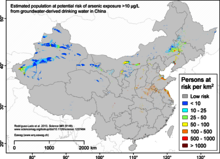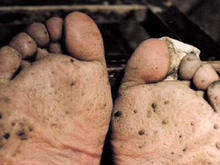News Detail
New Risk Model Sheds Light on Arsenic Risk in China's Groundwater
August 22, 2013 |
Since the 1960s, it has been known that groundwater resources in certain provinces of China are contaminated with arsenic. Estimates of the numbers of affected people have risen year by year. In the most recent survey – conducted by the Chinese Ministry of Health between 2001 and 2005 – more than 20,000 (5%) of the 445,000 wells tested showed arsenic concentrations higher than 50 µg/L. According to official estimates, almost 6 million people consume drinking water with an arsenic content of more than 50 µg/L and almost 15 million are exposed to concentrations exceeding 10 µg/L (the guideline value recommended by the WHO).
Given the sheer size of China and the time and expense involved in testing for arsenic contamination, several more decades would probably be required to screen all of the millions of groundwater wells. Accordingly, a group of researchers from Eawag and the China Medical University in Shenyang developed a statistical risk model making use of existing data on geology, soil characteristics and topographic features. This model was calibrated using available arsenic measurements. The predictions of unsafe or safe areas showed a high level of agreement, both for known high-risk areas and for areas where elevated arsenic levels had been ruled out by sampling campaigns.
In addition, large areas have now been identified as potentially at risk, such as the basins of the Tarim (Xinjiang), Ejina (Inner Mongolia) and Heihe (Gansu), or the North China Plain (Henan and Shandong). Arsenic concentrations above 10 µg/L are predicted for a total area of 580,000 km2. When these results were combined with the latest available population data, it was found that almost 20 million people across China live in high-risk areas. Geochemist Annette Johnson concedes: “This figure may be an overestimate, as we lack reliable information on the number of people with treated water supplies.” But in the long term, she adds, China will remain dependent on groundwater as a source of drinking water, particularly in the arid provinces. The risk model shows where conventional groundwater quality monitoring efforts are best focussed: “Our method permits more targeted sampling campaigns and saves time in identifying populations at risk. The Chinese authorities are adopting our maps in the national monitoring programme.” Johnson is convinced that the model could also be used in other countries where groundwater is known or suspected to be contaminated with arsenic – for example, in Africa or in central Asia, where risk assessments for arsenic contamination have not yet been performed.
Arsenic
Arsenic is one of the most common inorganic contaminants found in drinking water worldwide. This metalloid occurs as a natural component of sediments, with small quantities being dissolved in groundwater as a result of weathering. The inorganic salts of arsenic are tasteless and odourless, but highly toxic to humans. If ingested over long periods, even low concentrations can cause damage to health, including hyperpigmentation of the skin, hyperkeratosis on the palms and soles, disorders of liver, cardiovascular and kidney function, and various types of cancer.
Problems arise from the fact that firstly, arsenic concentrations can vary widely at the local level and, secondly, people in many areas are completely unaware of the risk because their groundwater wells have never been screened for arsenic. Concentrations below 10 µg/L are considered safe. This concentration is therefore recommended by the World Health Organization as a guideline value for arsenic in drinking water. In China, the standard guideline has just recently changed from 50 µg/L to 10 µg/L. In many other studies, e.g. at various sites in Inner Mongolia, arsenic concentrations of more than 100 µg/L and up to 1500 µg/L have been measured.
The maps (kmz-Files for overlays in Google Earth; please ask for at medien@cluttereawag.ch)
Media
they are only to be used in connection with this media release and are not to be archived.
Probability of groundwater arsenic contamination (concentrations over 10 µg/L) in China. The total area at risk is around 580,000 km2 (14 times the size of Switzerland). Rodriguez-Lado et al., Eawag, 2013.
Map showing densities of populations in China potentially exposed to excessive levels of arsenic in water. Particular concerns are raised by arid regions dependent on groundwater as a source of drinking water and high-risk areas with a high population density. (For comparison, population density in Switzerland averages 188 people/km2, only rising to 400 people/km2 on the Central Plateau.)
Arsenicosis at feet; scattered wart- or tumorlike nodi on the sole; toes also are affected; the patient suffers disorder in the blood circulation of toes
(© China Medical University, Shenyang)
Arsenicosis at feet; Advanced case of hyperkeratosis on the sole and toes resembles fish scales
(© China Medical University, Shenyang)
Arsenicosis at hand; coalescing plaques on the palm, especially on the thenar; fingers are seriously affected
(© China Medical University, Shenyang)
Hyperkeratosis on the palms and fingers and spreading towards the wrist; hyperkeratosis plaques have formed on the thenar of the right hand (This patient lost one and a half fingers in an accident and not due to arsenicosis)
(© China Medical University, Shenyang)
Original publication
Groundwater Arsenic Contamination throughout China; Luis Rodríguez-Lado, Guifan Sun, Michael Berg, Qiang Zhang, Hanbin Xue, Quanmei Zheng and Annette Johnson.
DOI http://www.sciencemag.org/lookup/doi/10.1126/science.1237484.
Financing Partners
- Sino-Swiss Science and Technology Cooperation Program of the Swiss State Secretariat for Education and Research, project No. IZLCZ2 123971
- The External Cooperation Program of the Chinese Academy of Sciences.
- National Science and Technology Pillar Program of China during the 11th Five-Year Plan Period (Contract grant number: 2006BAI06B04)







